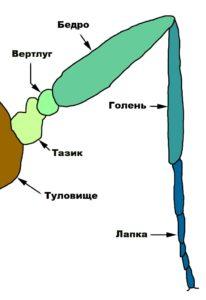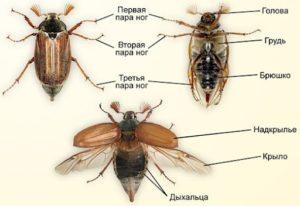How many paws does a beetle have: the structure and purpose of the limbs
The order of beetles has more than 390 thousand different species. They live in completely different conditions, lead different lifestyles and are very different in appearance from each other. But, there are a few traits that are common to all Coleoptera, and one of those is the number of legs.
Content
How many paws do bugs have
Regardless of species, each adult beetle has 6 limbs., which are conditionally divided into 3 pairs: front, middle and rear. Each pair of insect legs is attached to a corresponding thoracic region. The structure and functionality of all legs of beetles does not differ much from each other, but sometimes the back pair can be less mobile than the middle and front ones.
How are the limbs of beetles
The structure of the limbs of animals has common features, but depending on the lifestyle, some parts may be slightly modified. In all representatives of the order Coleoptera, the legs consist of five main parts:
- basin;
- swivel;
- hip;
- shin;
- paw.
The coxa and swivel provide maneuverability of the entire limb of the insect. The largest and strongest part of the leg is the thigh, since it is in this place that most of the muscles responsible for the movement of the insect are concentrated.
The lower leg is located between the thigh and the tarsus, and differs from other parts of the limb by the presence of spurs. The tarsi consist of several segments and, depending on the species, their number can vary from 1 to 5. In rare cases, segments are completely absent on the tarsi of the forelimbs.
There are stiff hairs on the underside of the tarsus, and its last segment is equipped with two sharp claws. The shape and length of these claws can vary greatly in different insects.
What can beetles do with their legs
Representatives of the order Coleoptera can live in a variety of conditions. Some of them live in sandy deserts, while others have completely adapted to life in the water. For this reason, the structure of the limbs can be very different. There are several main types of limbs in beetles:
- Walking. The tarsus of such limbs is usually wider and flattened, and its underside is covered with many hairs.
- running. Legs designed for running look thinner and more graceful. The tarsus is narrow and consists of 5 segments.
- Digging. Most often, the legs of the front pair are digging and their distinguishing feature is a wide, flat lower leg, surrounded by teeth on the outside.

- Swimming. characteristic of waterfowl. The tarsus and tibia of swimming legs are strongly flattened and widened, and also densely covered with stiff hairs.
- Jumping. This type of limb usually includes the hind pair of legs. Their distinguishing feature is thickened and strong hips.
- grasping. They are used by predatory species to capture prey, or help males keep the female in the process of mating. Such legs are usually very thin and long.
Conclusion
Like all other animals, beetles have evolved over the years, and they have adapted as much as possible to the conditions around them. For the sake of survival in the modern world, they changed very much in appearance, and it was for this reason that such different types of their limbs appeared, which differ in size, structure and purpose.
Previous
